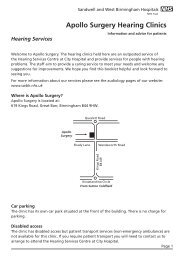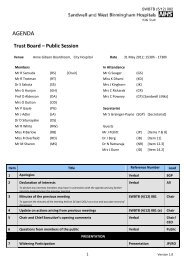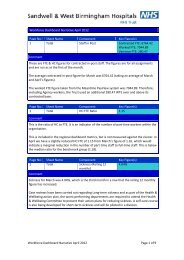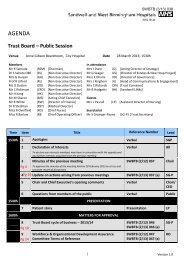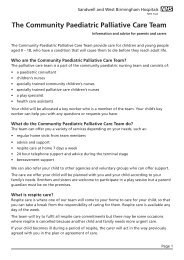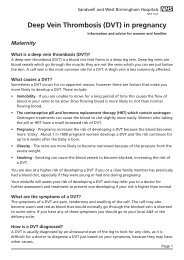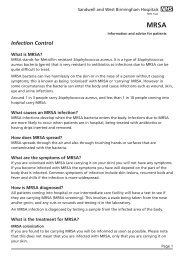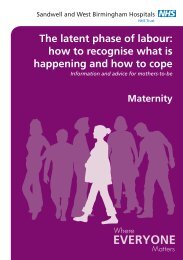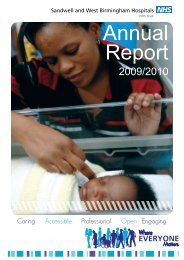January 2012 - Sandwell & West Birmingham Hospitals
January 2012 - Sandwell & West Birmingham Hospitals
January 2012 - Sandwell & West Birmingham Hospitals
Create successful ePaper yourself
Turn your PDF publications into a flip-book with our unique Google optimized e-Paper software.
SWBTB (1/12) 286 (a)<br />
OUTLINE BUSINESS CASE FOR CONSULTATION ON THE RECONFIGURATION<br />
OF ACUTE STROKE, TIA AND NEUROLOGY SERVICES<br />
1. INTRODUCTION<br />
Currently we provide acute and inpatient rehabilitation stroke and Transient Ischemic Attack<br />
(TIA) services at both City Hospital and <strong>Sandwell</strong> General Hospital. There are significant<br />
clinical drivers at a national, regional and local level to consolidate the acute element of these<br />
services in order to provide a critical mass of specialist experience and skills that can deliver<br />
improved health outcomes as measured by reduced mortality rates and increased numbers of<br />
patients returning to independent living following a stroke. In response to these drivers for<br />
change we have established, in partnership with our local commissioners, a project to identify<br />
and develop the options that will provide a configuration of services that delivers these<br />
improved outcomes for our local population.<br />
The purpose of this report is to outline for the Trust Board:<br />
the clinical case for reconfiguration of our acute stroke, Transient Ischemic Attack<br />
(TIA) and inpatient Neurology services,<br />
the short listed options,<br />
the case for formal public consultation on the proposed reconfiguration of these<br />
services, including the draft consultation document,<br />
the initial activity, capacity and financial analysis of the short listed options.<br />
2. STRATEGIC CONTEXT<br />
2.1 What are Acute Stroke and TIA Services?<br />
Hyper-acute stroke services enable patients to have rapid access to the right skills and<br />
equipment and be treated 24/7 on a dedicated stroke unit, staffed by specialist multidisciplinary<br />
teams. Following a stroke, a patient is taken directly to a hyper-acute stroke unit<br />
where they will receive expert care, including immediate assessment, access to a CT scan<br />
and clot-busting drugs (if appropriate) within 30 minutes.<br />
Following this acute care patients then receive inpatient based rehabilitation or are<br />
discharged to their usual place of residence with community rehabilitation as appropriate.<br />
Patients who have suffered a suspected TIA, also known as a ‘mini stroke’, can use an<br />
outpatient assessment service within 24 hours for those deemed to be at high risk of further<br />
TIA or stroke and within seven days for patients at lower risk.<br />
2.2 National and Regional Context<br />
Stroke has a major impact on people’s lives. It is caused by a disturbance of blood supply to<br />
the brain and may be ischemic or haemorrhagic in nature. It starts as an acute medical<br />
emergency, presents complex care needs, may result in long-term disability and can lead to<br />
admission to long-term care.<br />
Each year, 110,000 people in England and Wales have their first stroke, and 30,000 people<br />
go on to have further strokes. It is the single biggest cause of severe disability and the third<br />
most common cause of death in the UK. Over 5% of NHS resources and significant social<br />
care resources are devoted to the immediate and continuing care of people with stroke. In an<br />
average general hospital at any one time there are 25–35 patients with stroke as their primary<br />
diagnosis.<br />
4




